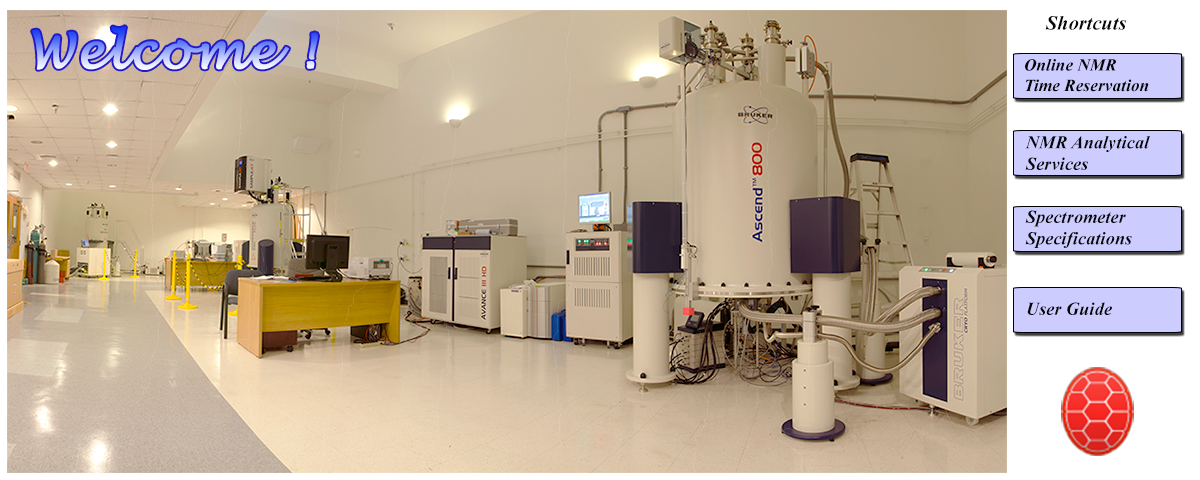
Instrumentation:
|
Featuring:
|
Facility Background
Established in year 2008, the Biomolecular NMR Facility is a core facility in the Department of Chemistry and Biochemistry at University of Maryland, College Park. The facility currently hosts three high field liquid NMR spectrometers and has the capability to run a wide range of liquid NMR experiments. Its user base includes scientists from various fields such as organic chemistry, medicinal chemistry, biochemistry, biophysics, polymer science, material science and bioengineering.
Research:
The facility provides high field NMR instrumentation to support University of Maryland research community through measurements of biomolecules, macromolecules and systems of biological interest. It also provides advanced training opportunities for students and acts as a hub for interdisciplinary collaborations.
Services:
The facility provides fast and reliable high resolution liquid NMR analysis to internal and external users. Samples can be organic, inorganic, polymer, biomolecules... Details are on NMR Services webpage.
Main users:
Dr. David Fushman
(Biophysical and Bioanalytical Chemistry, Theoretical and Computational Chemistry):Development and application of new experimental and theoretical approaches to study structural properties, dynamics, interactions, and regulation in multi-domain systems; polyubiquitin signaling; structure determination and analysis of proteins, nuclear magnetic resonance (NMR) and relaxation; computational biology; molecular dynamics simulations, physical and mathematical modeling.
Dr. Kwaku Dayie
(Bioorganic Chemistry, Biophysical and Bioanalytical Chemistry, Enzymology, Structural Biology, and Theoretical Chemistry):Structure, interactions, dynamics, and function of RNA complexes involved in catalysis and gene regulation; chemical biological methods of labeling RNAs; NMR methods development.
Biochemistry and Biophysics of Membrane Proteins, Membrane Protein NMR, Protein-Protein Interaction, Protein-Lipid Interaction, Viral Membrane Fusion, Magnetic Particle, Kidney Disease
Dr. Lawrence Sita
(Materials Chemistry, Nanoscience and Supramolecular Chemistry, Organometallic Chemistry and Catalysis, Surface Chemistry, Polymer Science and Chemical Technology):Synthetic, structural and mechanistic inorganic and organometallic chemistry; molecular and mesoscopic self-assembly processes; chemically modified surface and interfaces, polymer synthesis, development and utilization of low cost catalysts for commodity chemical production.
Nucleic acid structure, function, and catalysis. Structural DNA nanotechnology. RNA-protein interactions. Structure based drug design.
2022 to present
- If you test COVID-19 positive, you should not return to campus.
- Masks are a significant defense against the spread of COVID-19 and other respiratory viruses, so wearing a high-quality mask is recommended while indoors for added protection.
Indoor Masking Mandate, August 9, 2021
- the University of Maryland will now require masks to be worn indoors by all, regardless of vaccination status.
- Masks may be removed in the BioNMR lab if you are by yourself inside the lab.
COVID-19 Summer Restrictions Lifting May 28, 2021
- The BioNMR Facility has returned to full capacity.
- If you are fully vaccinated, you will no longer be required to wear a face mask in the NMR room.
- If you are not fully vaccinated, you will be required to wear a face mask.
CP800 Computer upgrade to Windows 10 and TopSpin3.6.2, March 2020
The upgraded TopSpin 3.6.2 is on harddrive C, while the NMR data is located under G:/Bruker/TopSpin3.5pl6/data.
- The computer and FTP logins are unchanged for most of the regular/active CP800 NMR users. To infrequent or inactive users, please contact the facility manager for re-creating a login.
- TopSpin 3.6.2 interface is only slightly different from TopSpin3.5.6. All previously user defined pulseprograms and related files have been transfered to TopSpin 3.6.2. In case any files were not transferred successfully, you may manually copy from TopSpin 3.5.6 folder on G drive to TopSpin 3.6.2 on C drive.
- Remote access is allowed for now due to the campus access restriction and Coronavirus crisis. To make Remote access work, first one needs to activate cisco VPN client software on his/her computer, which can be downloaded from Terpware website. Please note that Remote Desktop may cause computer screen to lock up. Therefore, one will need to come to the lab to unlock the screen or notify the next user to reboot the computer before the next user can access the computer/TopSpin.






